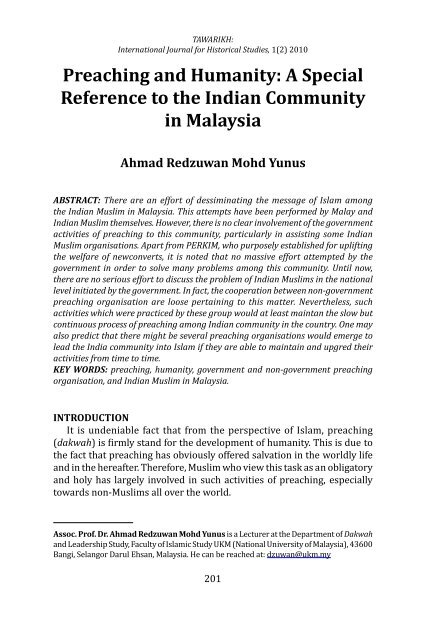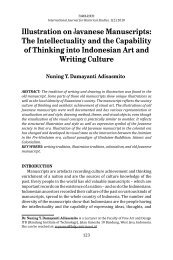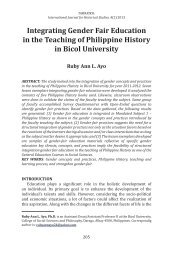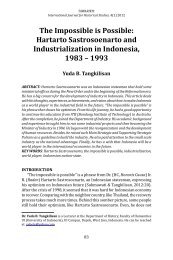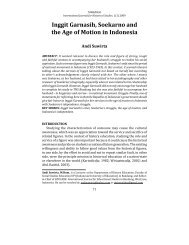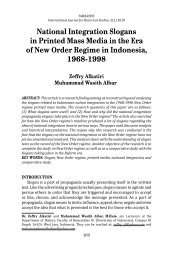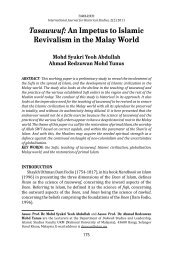The full article is as follows. - Tawarikh Journal
The full article is as follows. - Tawarikh Journal
The full article is as follows. - Tawarikh Journal
You also want an ePaper? Increase the reach of your titles
YUMPU automatically turns print PDFs into web optimized ePapers that Google loves.
TAWARIKH:International <strong>Journal</strong> for H<strong>is</strong>torical Studies, 1(2) 2010Preaching and Humanity: A SpecialReference to the Indian Communityin MalaysiaAhmad Redzuwan Mohd YunusABSTRACT: <strong>The</strong>re are an effort of dessiminating the message of Islam amongthe Indian Muslim in Malaysia. Th<strong>is</strong> attempts have been performed by Malay andIndian Muslim themselves. However, there <strong>is</strong> no clear involvement of the governmentactivities of preaching to th<strong>is</strong> community, particularly in <strong>as</strong>s<strong>is</strong>ting some IndianMuslim organ<strong>is</strong>ations. Apart from PERKIM, who purposely establ<strong>is</strong>hed for upliftingthe welfare of newconverts, it <strong>is</strong> noted that no m<strong>as</strong>sive effort attempted by thegovernment in order to solve many problems among th<strong>is</strong> community. Until now,there are no serious effort to d<strong>is</strong>cuss the problem of Indian Muslims in the nationallevel initiated by the government. In fact, the cooperation between non-governmentpreaching organ<strong>is</strong>ation are loose pertaining to th<strong>is</strong> matter. Nevertheless, suchactivities which were practiced by these group would at le<strong>as</strong>t maintan the slow butcontinuous process of preaching among Indian community in the country. One mayalso predict that there might be several preaching organ<strong>is</strong>ations would emerge tolead the India community into Islam if they are able to maintain and upgred theiractivities from time to time.KEY WORDS: preaching, humanity, government and non-government preachingorgan<strong>is</strong>ation, and Indian Muslim in Malaysia.INTRODUCTIONIt <strong>is</strong> undeniable fact that from the perspective of Islam, preaching(dakwah) <strong>is</strong> firmly stand for the development of humanity. Th<strong>is</strong> <strong>is</strong> due tothe fact that preaching h<strong>as</strong> obviously offered salvation in the worldly lifeand in the hereafter. <strong>The</strong>refore, Muslim who view th<strong>is</strong> t<strong>as</strong>k <strong>as</strong> an obligatoryand holy h<strong>as</strong> largely involved in such activities of preaching, especiallytowards non-Muslims all over the world.Assoc. Prof. Dr. Ahmad Redzuwan Mohd Yunus <strong>is</strong> a Lecturer at the Department of Dakwahand Leadership Study, Faculty of Islamic Study UKM (National University of Malaysia), 43600Bangi, Selangor Darul Ehsan, Malaysia. He can be reached at: dzuwan@ukm.my201
AHMAD REDZUWAN MOHD YUNUS,Preaching and HumanityIn Malaysia, preaching which w<strong>as</strong> perceptibly observed to be a forceof social change, particularly in the seventies h<strong>as</strong> involved many outreachactivities towards non-Muslims including the Indian community. Actually,Islam <strong>is</strong> not new for th<strong>is</strong> community since Indian people h<strong>as</strong> already knownthe religion since it w<strong>as</strong> spread in their motherland, Indian subcontinent.However, such attempt to convert them into Islam <strong>is</strong> not <strong>as</strong> e<strong>as</strong>y <strong>as</strong> usuallypresumed. As a community who h<strong>as</strong> its own identity, Indian h<strong>as</strong> alsostruggled to preserve its human<strong>is</strong>tic tradition.<strong>The</strong> paper will d<strong>is</strong>cuss th<strong>is</strong> <strong>is</strong>sue which focuses on two importantquestions, namely: (1) how preaching <strong>is</strong> being conducted among Indians;and (2) how do they response towards th<strong>is</strong> so called human<strong>is</strong>tic approachof preaching?THE MIGRATION OF THE INDIAN COMMUNITY TO MALAYSIAOne of the communities in Malaysia at present <strong>is</strong> the Indian community.<strong>The</strong>y are the third largest community and <strong>is</strong> numbered at 2.5 million people.<strong>The</strong> majority of them are centred in Kuala Lumpur, Selangor, Perak, Penanand a few other states. <strong>The</strong>y migration to Malaysia before independencehad formed a community with its own identity. <strong>The</strong>ir ex<strong>is</strong>tence have alsomade them <strong>as</strong> a main target for the m<strong>is</strong>sionary movement in Malaysia.Due to the fact that Islam <strong>is</strong> a m<strong>is</strong>sionary religion, there are a numberof m<strong>is</strong>sionary movements such <strong>as</strong> PERKIM (Persatuan Kebijakan IslamMalaysia or Islamic Welfare Organ<strong>is</strong>ation of Malaysia), Islamic Outreach-ABIM (Angkatan Belia Islam Malaysia or Young Muslim Brigade ofMalaysian), Indian Mosque (M<strong>as</strong>jid India), PERMIM (Persatuan MuslimIndia Malaysia or Indo-Muslim Federation of Malaysia), and others whichconduct m<strong>is</strong>sionary activities using various approaches, either to convertthem <strong>as</strong> Muslims or strengthen their faith in Islam that they have convertedinto. During the m<strong>is</strong>sionary activities among the Indians, a few challengeshave been identified. <strong>The</strong>y will be briefly d<strong>is</strong>cribed in th<strong>is</strong> paper.H<strong>is</strong>tory h<strong>as</strong> stated that Indians came to Malaya about 2,000 years agoand they are divided into two groups: the early migrants and the modernmigrants. <strong>The</strong> early migrants were the elite <strong>as</strong> they came <strong>as</strong> merchants andcalled Malaya <strong>as</strong> Suverarnabhumi or “Golden Land”. <strong>The</strong> modern migrantscame during the Brit<strong>is</strong>h colonial period and worked <strong>as</strong> rough labourersand w<strong>as</strong> paid low wage to work in the sugar cane and coffee plantations.Only in the 19 th century, did they move to the rubber industry which w<strong>as</strong>before th<strong>is</strong> controlled by the Malays.<strong>The</strong>re were a number of factors which encouraged them to come toMalaya. <strong>The</strong> economic development of Malaya w<strong>as</strong> an important factor that202
TAWARIKH:International <strong>Journal</strong> for H<strong>is</strong>torical Studies, 1(2) 2010encouraged migrants to th<strong>is</strong> country, especially the Chinese and Indians.<strong>The</strong> economy situation of Malaya in the first 20 years of the 20 th centuryshowed a vibrant economy. According to stat<strong>is</strong>tics, between 1898 and 1905,the tin production of Malaya w<strong>as</strong> half the world’s production. Althoughthere w<strong>as</strong> competition from other countries such <strong>as</strong> Bolivia and Nigeria,Malaya remained the main producer of tin. <strong>The</strong> proof <strong>is</strong> seen, when theactivities of tin mining brought in a m<strong>as</strong>s migration of Chinese migrantsto Malaya to work in the tin mines.Besides profits from tin, rubber also brought in profit for Malaya. In1905, there were 38,000 acres of rubber plantation. Th<strong>is</strong> incre<strong>as</strong>ed to100,000 acres in the following year. Due to incre<strong>as</strong>ed demand, the Brit<strong>is</strong>htook steps to expand rubber plantations to the whole of Malaya. It <strong>is</strong> dueto th<strong>is</strong> development that the Brit<strong>is</strong>h brought in Indian migrants to work inthe rubber plantations. Furthermore, they provided labour that w<strong>as</strong> e<strong>as</strong>ilyavailable and cheaper <strong>as</strong> compared to the locals.<strong>The</strong> date of Indian migrant labourers to Malaya w<strong>as</strong> said to be circa1786, after the Brit<strong>is</strong>h took over Penang. <strong>The</strong>y were brought in to workeither <strong>as</strong> servants or labourers in the plantation sector. At the end of the18 th century, their number incre<strong>as</strong>ed following the opening of Singapore in1819 (Tregonning, 1962:44). <strong>The</strong>refore, in 1910 there w<strong>as</strong> a m<strong>as</strong>s migrationwhereby 2,532 Indian labourers were brought in through Penang. In 1921,the number of labourers coming in incre<strong>as</strong>ed and w<strong>as</strong> estimated to bearound 100,000 people.According to Zainal Abidin Abdul Wahid (1979:111), many werebrought into Malaya through contracts. According to the contracts, theywere to work for a period of time, usually three years. <strong>The</strong> contracts werefor those who reg<strong>is</strong>tered with recruiting agents in India. Th<strong>is</strong> system w<strong>as</strong>known <strong>as</strong> “a regularly organ<strong>is</strong>ed system of kidnapping”. Th<strong>is</strong> system workedbetween 1910 and 1938 and w<strong>as</strong> known <strong>as</strong> a contract labourer system.<strong>The</strong>n it changed to the Kangany system and it <strong>is</strong> said that th<strong>is</strong> system w<strong>as</strong>more profitable for the Brit<strong>is</strong>h <strong>as</strong> the wage rate given w<strong>as</strong> lower and theworkers were of more quality.Besides the rubber plantations, the Brit<strong>is</strong>h tried to diversify theagricultural activities in Malaya by introducing crops such <strong>as</strong> tea and coffee.It w<strong>as</strong> obvious that tea planting received much welcome and high demand.Besides rubber, tea and coffee, the Brit<strong>is</strong>h also opened coconut and palmoil plantations. Following th<strong>is</strong>, the Brit<strong>is</strong>h brought in Indian labourers towork in these plantations. For example, in 1957, 54% of Indian labourersworked in palm oil plantations and th<strong>is</strong> number incre<strong>as</strong>ed from year toyear (Sandhu & Mani, 1993:164).203
AHMAD REDZUWAN MOHD YUNUS,Preaching and HumanityApart from their migration <strong>as</strong> labourers, the development wave ofMalaya also attracted educated Indians to come to Malaya to work <strong>as</strong>lawyers, doctors and <strong>as</strong> such (Tregonning, 1962:52). <strong>The</strong>re were also amongthem who involved themselves in small and big businesses. Initially, theirmigration w<strong>as</strong> not for permanent stay in Malaya. However, with the facilitiesprovided by the Brit<strong>is</strong>h such <strong>as</strong> education, housing and employment, theydecided to stay on on in Malaya.PREACHING TO THE INDIAN COMMUNITYAs w<strong>as</strong> explained in the introduction, there are a few preaching movementswhich h<strong>as</strong> taken various efforts to preach to the Indian community suchPERKIM, Islamic Outreach-ABIM, M<strong>as</strong>jid India, and PERMIM. <strong>The</strong>ir rolesin the m<strong>is</strong>sionary movement <strong>is</strong> explained <strong>as</strong> <strong>follows</strong>:A. PERKIM (Persatuan Kebijakan Islam Malaysia)<strong>The</strong> acronym for PERKIM <strong>is</strong> the Islamic Welfare Organ<strong>is</strong>ation of Malaysia.It w<strong>as</strong> initiated by the late Tunku Abdul Rahman Putra around 1960. As awelfare body, it w<strong>as</strong> not surpr<strong>is</strong>ing that PERKIM sucess<strong>full</strong>y attracted nonMuslim Indians to convert to Islam. Among the welfares handed out weresupport letters to apply for houses, trading licences, school reg<strong>is</strong>trations,shelters, orphanages, vocational courses, hostel schools and <strong>as</strong> such. Besidesthe welfare factor, the other factors attracting converts were the talks, cl<strong>as</strong>sesin their mother tongue and counselling services which also helped thecommunity to approach Islam (Mahayudin Abu Bakar, 1994:121-122).B. Islamic Outreach-ABIMIslamic Outreach-ABIM <strong>is</strong> a preaching agency under the patronageof ABIM (Angkatan Belia Islam Malaysia). IOA (Islamic Outreach-ABIM)w<strong>as</strong> set up to spread Islam among the non Muslims and new converts inMalaysia. Among the activities of IOA <strong>is</strong> to hold Islamic cl<strong>as</strong>ses, a place tomeet and exchange opinions among the converts, hold seminars, forums,publications, provide health service, provide lodging sevices and set up aa village for converts <strong>as</strong> in Banting, Selangor.<strong>The</strong> Banting project w<strong>as</strong> one of the efforts of IOA for the Indians wholive in estates. Among the main objectives of th<strong>is</strong> project <strong>is</strong> to promoteIslam to the Indians who work in the estates, making it a b<strong>as</strong><strong>is</strong> for efforts topropagate other Indians and to provide guidance and <strong>as</strong>s<strong>is</strong>tance to developthose who are poor. In the efforts to make Banting project a success, IOAheld weekly Saturday cl<strong>as</strong>ses in Tamil for converts. It also helped financethe schooling of the very poor to further their studies in religious schools.204
TAWARIKH:International <strong>Journal</strong> for H<strong>is</strong>torical Studies, 1(2) 2010Financial <strong>as</strong>s<strong>is</strong>tance such <strong>as</strong> loans and agricultural <strong>as</strong>s<strong>is</strong>tance were alsogiven (Mahayudin Abu Bakar, 1994:121-122). <strong>The</strong> Banting project w<strong>as</strong>placed under an Indian convert Dr. Mohd Sivalingam with the help of a groupof activ<strong>is</strong>ts “Banting Convert V<strong>is</strong>its”. <strong>The</strong>y will v<strong>is</strong>it to forge better ties and<strong>as</strong> encouragement to the new converts to be able to live <strong>as</strong> Muslims.C. Indian MosqueTh<strong>is</strong> <strong>is</strong> the symbol of commitment of the Indian community to Islamand unity among the community. Th<strong>is</strong> <strong>is</strong> where religious education (talks,sermons and tazkirah) in Tamil are presented by several religious teachers.Most of them are of the Hanafi sect. <strong>The</strong> mosque <strong>is</strong> also a stop over forIndians who have just arrived from India and are looking for employmentin Malaysia. It <strong>is</strong> also a place for social<strong>is</strong>ing among them. Through the Imamof the mosque, the community also sends messages, things and others totheir families in India whenever the Imam returns to India. <strong>The</strong>refore, wefind the mosque plays an important role to the Tamil Muslims in Malaysiaand Kuala Lumpur specifically. It <strong>is</strong> thus not surpr<strong>is</strong>ing why many TamilMuslims pray there, especially during Fridays and other times <strong>as</strong> thelanguage that <strong>is</strong> used makes it e<strong>as</strong>ier for them to understand the messagethat <strong>is</strong> being conveyed.D. PERMIM (Persatuan Muslim India Malaysia)PERMIM <strong>is</strong> the acronym of the Indo-Muslim Federation of Malaysia,started in 1973. <strong>The</strong> movement <strong>is</strong> active in preaching to the IndianMuslim specifically and to the Muslim community <strong>as</strong> a whole. <strong>The</strong>re area few activities from various angles that have been accompl<strong>is</strong>hed by th<strong>is</strong>movement, such <strong>as</strong> from the education, economy and social sector topromote the teachings of Islam.Real<strong>is</strong>ing that education will change and pattern lives, PERMIM holdsfardhu ‘ain (individual obligation) cl<strong>as</strong>ses almost everyday except on publicholidays to the Indian Muslim community in all of its div<strong>is</strong>ions which <strong>is</strong> at thereligious schools that have been set up. Among the lessons given importanceduring these cl<strong>as</strong>ses are tauhid, iqh and hadith. Importance <strong>is</strong> placed onQuranic studies to ensure reading among the community. To expand thecommunity’s knowledge on Islam, the organ<strong>is</strong>ation also sponsors coursessuch <strong>as</strong> Islamic undertsanding courses and these courses are usually givenby staff of the Islamic Religious Department where these courses are heldIslamic education also spread wide information to th<strong>is</strong> community throughthe reading materials such <strong>as</strong> the magazine of Nam Kural and the book titledHoly al-Quran-A Scentific Perspective by Moulovi H<strong>as</strong>an.205
AHMAD REDZUWAN MOHD YUNUS,Preaching and HumanityTo prepare Indian Muslim students to face government exams such <strong>as</strong>SPM (Sijil Pelajaran Malaysia) and STPM (Sijil Tinggi Pelajaran Malaysia),PERMIM organ<strong>is</strong>es examination workshops. Among the subjects givenimportance are Bah<strong>as</strong>a Malaysia, Engl<strong>is</strong>h, H<strong>is</strong>tory, Mathematics and Science.According to Anver Hussein (interveiw on 29/12/1997), RM150 <strong>is</strong> allocatedfor each student to ensure the workshop <strong>is</strong> a success. If there are studentsamong them who are successful in their studies and have the opportunityto further their studies to a tertiary level, public or private, the organ<strong>is</strong>ationallocates five loans to five students annually. Islamic education <strong>is</strong> also donethrough the electronic media by th<strong>is</strong> organ<strong>is</strong>ation through the programmeUswah which <strong>is</strong> organ<strong>is</strong>ed by the Da’wah Section of Radio Telev<strong>is</strong>yenMalaysia or RTM2 (Ahmad Redzuwan Mohd Yunus, 1998:65).<strong>The</strong> role of PERMIM in the economic field to develop the Indian Muslimcommunity <strong>is</strong> quite obvious <strong>as</strong> compared to its roles in other fields. Th<strong>is</strong> <strong>is</strong>because of their tendency of the community towards business. To achieveth<strong>is</strong>, a seminar titled “Business by V<strong>is</strong>ion 2020” w<strong>as</strong> organ<strong>is</strong>ed by them.<strong>The</strong> consciousness of the organ<strong>is</strong>ation towards their community also sawthem providing <strong>as</strong>s<strong>is</strong>tance such <strong>as</strong> Hari Raya <strong>as</strong>s<strong>is</strong>tance every year. <strong>The</strong>main motive for th<strong>is</strong> w<strong>as</strong> to enable those in need to be able to celebrate thefestival <strong>as</strong> others. Beside these, the organ<strong>is</strong>ation also provides <strong>as</strong>s<strong>is</strong>tance tothe unfortunate and th<strong>is</strong> noble deed <strong>is</strong> also extended to the internationallevel by providing <strong>as</strong>s<strong>is</strong>tance to the Bosnian Fund, which <strong>is</strong> provided forby the community.Through social <strong>as</strong>pects, the organ<strong>is</strong>ation strengthens the relationshipbetween Indian Muslims at div<strong>is</strong>ion level where PERMIM h<strong>as</strong> held dialogueswith the youths. Dialogues are held to find solutions to problems withinthe community. Usually, the div<strong>is</strong>ion level will present their problems toPERMIM during the dialogue sessions before the problems are forwardedto the government. <strong>The</strong> organ<strong>is</strong>ation also holds relationship strengtheningfunctions between themselves. <strong>The</strong>se functions are held with fe<strong>as</strong>ts. <strong>The</strong>objective of these functions <strong>is</strong> to enable the Indian Muslim community ofall levels to be able to gather and exchange ide<strong>as</strong> and get to know eachother. Hari Raya functions are also held for the same re<strong>as</strong>on. Breaking f<strong>as</strong>tsfunctions are also held and th<strong>is</strong> <strong>is</strong> quite a popular activity among them <strong>as</strong>it <strong>is</strong> held quite often.Besides these activities, other important days in Islam such <strong>as</strong> Lailatal-Qadr, Mawlid al-R<strong>as</strong>ul, and Isra’ Mikraj <strong>is</strong> remember with talks by invitedspeakers, be they foreign or local and these programmes are held everyyear although it does not involve all div<strong>is</strong>ions. Special talks are also heldby those with knowledge <strong>as</strong> the community needs continuous religious206
TAWARIKH:International <strong>Journal</strong> for H<strong>is</strong>torical Studies, 1(2) 2010education and usually the main location <strong>is</strong> the mosque. Among thoseprominent figures who have poured in their efforts among the IndianMuslim community are Dr. Hj. Mohd Iqbal, Dr. Hamina Syed (India), Maulanaal-Haj H<strong>as</strong>san Azhari (Sri langka), Moulovi S. Sheikh Nuri, Moulovi AbdullahBukhari, Moulavi Abul Q<strong>as</strong>im, and others.CHALLENGES AND OBSTACLES FACED IN PREACHING ACTIVITIES TOTHE INDIAN COMMUNITY<strong>The</strong>re are a number of challenges and obstacles that have been identifiedin the efforts to spread da’wah (preaching) to the Indian community inMalaysia. Nevertheless, the writer would only describe two importantfactors which are believed to be the great challenge for the process ofpreaching among Indians in the country.First <strong>is</strong> about M<strong>is</strong>sionaries. It <strong>is</strong> real<strong>is</strong>ed that the most obvious problemfaced by the preaching movement to spread Islam to the non Muslims <strong>is</strong> theshortage of m<strong>is</strong>sionaries among the communities themselves, what morethe experienced and experts. <strong>The</strong>refore, the organ<strong>is</strong>ation occ<strong>as</strong>sionallyinvites foreign m<strong>is</strong>sionaries when they want to hold religious activitiessuch <strong>as</strong> religious talks and <strong>as</strong> such. <strong>The</strong> situation <strong>is</strong> more critical <strong>as</strong> them<strong>is</strong>sionaries that are needed should be able to communicate in Tamilto spread Islam. Th<strong>is</strong> <strong>is</strong> because the target <strong>is</strong> e<strong>as</strong>ier when the languageused during the activities <strong>is</strong> e<strong>as</strong>ily understood by them to enable them tounderstand the message being conveyed. <strong>The</strong> above factor <strong>is</strong> probably dueto Indian Muslim community itself which <strong>is</strong> too busy to volunteer sometime to spread Islam to the Indian Muslim community. <strong>The</strong>y are busy andtired due to the fact that a majority of them are business people, in otherwords, self employed. <strong>The</strong>refore, there are some Malay m<strong>is</strong>sionaries whoorgan<strong>is</strong>e functions although the target <strong>is</strong> the Indian Muslim community.Since the language used in Malay, the Indian community cannot properlyfollow the activities although they are from those highly religious educatedand very credible (interview with Anver Hussein, 29/12/1997).Second, Challenge of Other Religions. As a new converts, one mayreal<strong>is</strong>e that the root of the challenge <strong>is</strong> b<strong>as</strong>ically ar<strong>is</strong>e from their formerreligion i.e. Hindu<strong>is</strong>m. Some of them cannot be totally separated fromtheir former customs and culture. <strong>The</strong>y still pract<strong>is</strong>ing some un-Islamicelements, particularly during the v<strong>is</strong>it to their Hindus families. <strong>The</strong> family,especially those who are strongly against their conversion into Islam, alsokeep persuading them to reconvert into their former religion. <strong>The</strong> situationbecome more serious when some of them are even using such forcefulmeans in order to achieve th<strong>is</strong> objective. <strong>The</strong>re are several c<strong>as</strong>es reporting207
AHMAD REDZUWAN MOHD YUNUS,Preaching and Humanityabout th<strong>is</strong> battle, particularly in the non mainstream newspapers. Apartfrom the family, the new converts also find that they are difficult to havefriends and lovers among Malays. Alternatively, some of them turn to theirHindus fellows and their Islamic believe and practice become vulnerablefor any reconversion attempts (interview with Maideen Abd. Rahman,29/12/1997).It <strong>is</strong> also noted that the Chr<strong>is</strong>tianity become another great challenge forboth Islam and Hindu<strong>is</strong>m. <strong>The</strong> m<strong>is</strong>sionaries activities among India sincethe coming of th<strong>is</strong> community in the country have shown the incre<strong>as</strong>enumber of conversion into th<strong>is</strong> Western religion. Since th<strong>is</strong> religion <strong>is</strong>closely <strong>as</strong>sociated with modern Western religion, many of them are proudto be Chr<strong>is</strong>tians rather than Muslims who <strong>is</strong> greatly been portrayed <strong>as</strong> aterror<strong>is</strong>t or fanatics. It <strong>is</strong> also believed that the proactive and dynamicapproaches of dialogue promoted by the church and m<strong>is</strong>sionary bodiesh<strong>as</strong> contributed to the growth of Indian conversion, particulary amongthe poor estates workers.Moreover, it <strong>is</strong> accepted by the Muslim m<strong>is</strong>sionary that economic factorbecome one of the most crucial problem for the activity of preaching.For instance, Anver Hussein h<strong>as</strong> clearly mentioned that many preachingactivities, particularly in order to challenge and counter the Chr<strong>is</strong>tianm<strong>is</strong>sion, have faced financial problems (interview with Anver Hussein,29/12/1997). Many Indian Muslim <strong>as</strong>sociation have relied on donationor sadaqah to run their programs. Financial helps from other governmentor dominant preaching organ<strong>is</strong>ations are very limited. In general, Indiancommunity who mostly suffered economically are keen to look for any<strong>as</strong>s<strong>is</strong>tance from the Chr<strong>is</strong>tian bodies rather than Islam (interview withMaideen Abd. Rahman, 29/12/1997).CONCLUSIONIn conclusion, we may say that there are an effort of d<strong>is</strong>seminating themessage of Islam among the Indian Muslim in Malaysia. Th<strong>is</strong> attempts havebeen performed by Malay and Indian Muslim themselves. However, there <strong>is</strong>no clear involvement of the government activities of da’wah (preaching) toth<strong>is</strong> community, particularly in <strong>as</strong>s<strong>is</strong>ting some Indian Muslim organ<strong>is</strong>ations.Apart from PERKIM, who purposely establ<strong>is</strong>hed for uplifting the welfare ofnewconverts, it <strong>is</strong> noted that no m<strong>as</strong>sive effort attempted by the governmentin order to solve many problems among th<strong>is</strong> community.Until now, there are no serious effort to d<strong>is</strong>cuss the problem of IndianMuslims in the national level initiated by the government. In fact, thecooperation between non-government da’wah (preaching) organ<strong>is</strong>ation208
TAWARIKH:International <strong>Journal</strong> for H<strong>is</strong>torical Studies, 1(2) 2010are loose pertaining to th<strong>is</strong> matter. Nevertheless, such activities which werepracticed by these group would at le<strong>as</strong>t maintan the slow but continuousprocess of preaching among Indian community in the country. One mayalso predict that there might be several preaching organ<strong>is</strong>ations wouldemerge to lead the India community into Islam if they are able to maintainand upgred their activities from time to time.ReferencesAhmad Redzuwan Mohd Yunus. (1998). ”Metodologi Dakwah kepada M<strong>as</strong>yarakat IndiaMuslim: Satu Kajian di Persekutuan Muslimin Indo-Malaysia (PERMIM)”. UnpublihedPh.D. D<strong>is</strong>sertation. Bangi: UKM [National University of Malaysia].Interveiw with Anver Hussein <strong>as</strong> Syarikat Saudagar Kert<strong>as</strong> Kamila Sdn.Bhd. in Kuala Lumpur,Malaysia, on 29 December 1997.Interveiew with Maideen Abd. Rahman <strong>as</strong> Syarikat Saudagar Kert<strong>as</strong> Kamila Sdn. Bhd. inKuala Lumpur, Malaysia, on 29 December 1997.Mahayudin Abu Bakar. (1994). “Perkembangan Dakwah Islamiah di Kalangan M<strong>as</strong>yarakatIndia di Wilayah Persekutuan dan Selangor”. Unpublihed Undergraduate <strong>The</strong>s<strong>is</strong>. Bangi:UKM [National University of Malaysia].Maktab Kerj<strong>as</strong>ama Malaysia. (1996). “Laporan Jawatanku<strong>as</strong>a Kecil Pendidikan dalamMesyuarat Agung Dwi Tahunan yang ke Sebel<strong>as</strong> di Petaling Jaya, Selangor Darul Ehsan,Malaysia, pada 24 November 1996”. Unpublihshed Report.Sandhu, S. & A. Mani. (1993). India Communities in Southe<strong>as</strong>t Asia. Singapore: Institute ofSouthe<strong>as</strong>t Asia Studies.Tregonning, K.G. (1962). Malaysian H<strong>is</strong>tory Sources. Singapore: University of Singapore.Zainal Abidin Abdul Wahid. (1979). Sejarah Malaysia Sepint<strong>as</strong> Lalu. Kuala Lumpur: DewanBah<strong>as</strong>a dan Pustaka.209
AHMAD REDZUWAN MOHD YUNUS,Preaching and HumanityUntil now, there are no serious effort to d<strong>is</strong>cuss the problem of Indian Muslims inthe national level initiated by the government. In fact, the cooperation between nongovernmentda’wah (preaching) organ<strong>is</strong>ation are loose pertaining to th<strong>is</strong> matter.210


